The Critical Lowdown Podcast Episode 8
Recorded at the Internet Service Providers UK Business Model Summit
Mark Downey, EPS Global in conversation with Bhartendu Chaurasia, Meta/Facebook & TIP
As 5G networks and 5G-enabled technologies become more prevalent, experts expect the sustainability opportunity of 5G to be high on the agenda for service providers this year and next. How can we drive sustainable network innovation to keep pace with the exponential growth in network traffic, and can open telecom technology bring more people better internet access across all 4 corners of the globe?
We asked this very question at the Internet Service Providers Business Model Summit in London this month, where our Head of Sales for Northern Europe & Africa, Mark Downey, sat down with Bhartendu Chaurasia, the Head of Telecom Infra Project Technologies for EMEA at META/Facebook.
The Telecom Infra Project was formed in 2016 as an engineering-focused, collaborative methodology to accelerate the development and deployment of global telecom network infrastructure. This innovative, shared approach addresses challenges such as scalability, fast convergence, and ease of configuration to deliver high-quality connectivity, even to remote areas. By simplifying the network architecture, they can improve flexibility and efficiency which reduces the most significant costs of keeping a network up and running, which are ongoing operations and maintenance.
EPS Global has been working with TIP for the past few years, both directly with Service Providers opting for TIP-based solutions and also as TIP’s fulfilment partner, getting open hardware and software into the hands of their end customers.
Subscribe to The Critical Lowdown from EPS Global wherever you get your podcasts:
Transcript of Episode 8: Driving Sustainable Network Innovation with Open Telecom Technology
Mark Downey: The topic of today's talk is driving sustainable network innovation with Open Telecom technology. So before that, I just wanted to explain where EPS Global fits into that picture, and then I will ask Bhartendu some questions.
We've been ISPA’s Open Disaggregated partner now for 2 years, and we were set up in 1999. We have 28 global locations around the world covering Asia, Europe/EMEA and the Americas. We specialize in solutions that are based on open standards, bare metal hardware, and open software. We work with ISPs all around the world, some of which are in the UK, promoting these open standards and helping them deliver on their networks. Open is great, but in reality you want someone to pull it all together for you. We get involved in initializing and provisioning switches and setting them up and getting them out to our customers.
We've also been working with the Telecom Infra Project, which is what Bhartendu is part of, both directly with customers deploying those solutions out there; and also helping as a fulfilment partner to get the solutions to their customers. We’re delighted to time with Bhartendu today who’s a wealth of knowledge, hopefully interesting for you guys.
Bhartendu, we've got a room full of people here today, ISPs and Service Providers who probably have a varying degree of knowledge about TIP and what you do. Could you give them a bit of an overview of what you do?
Bhartendu Chaurasia: Excellent. Thanks Mark. First of all, thanks for having me here. My name is Bhartendu. I work for Meta Connectivity. My role is to develop partner relationships in Europe, Middle East and Africa. Connectivity is very important for Meta and that's why we are part TIP. For those who don't know what TIP is, it stands for Telecom Infra Project. It started in 2016 with 20 companies, mostly MNOs coming together, and in the past 5 years it has grown to 500+ companies across the globe, it’s a really a global initiative. By definition, it's a community approach where organizations and companies have come together to develop and deploy open disaggregated technologies which are based on standards and which will fulfill the needs of today and tomorrow.
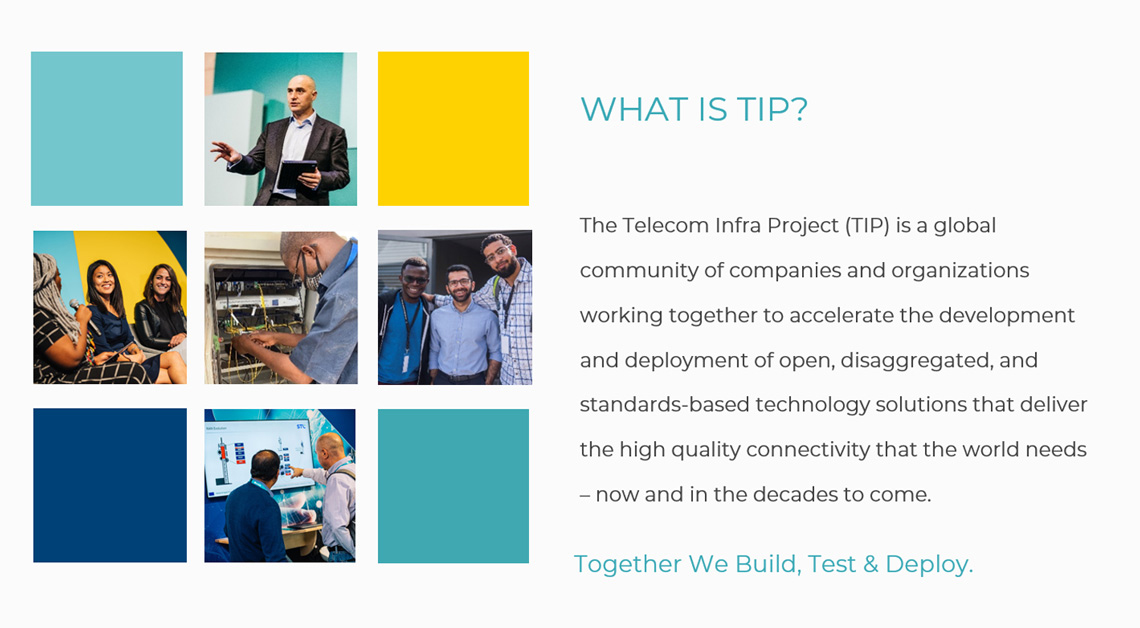
The line at the bottom of the slide is very intentional. Together we build, test and deploy. The most important part in this in this sentence is together. We are very much focused on building collaboration, global synergies, testing things together, and then sharing the results with the community. The motto is test once, deploy many times. With this philosophy, I'll explain why TIP exists.
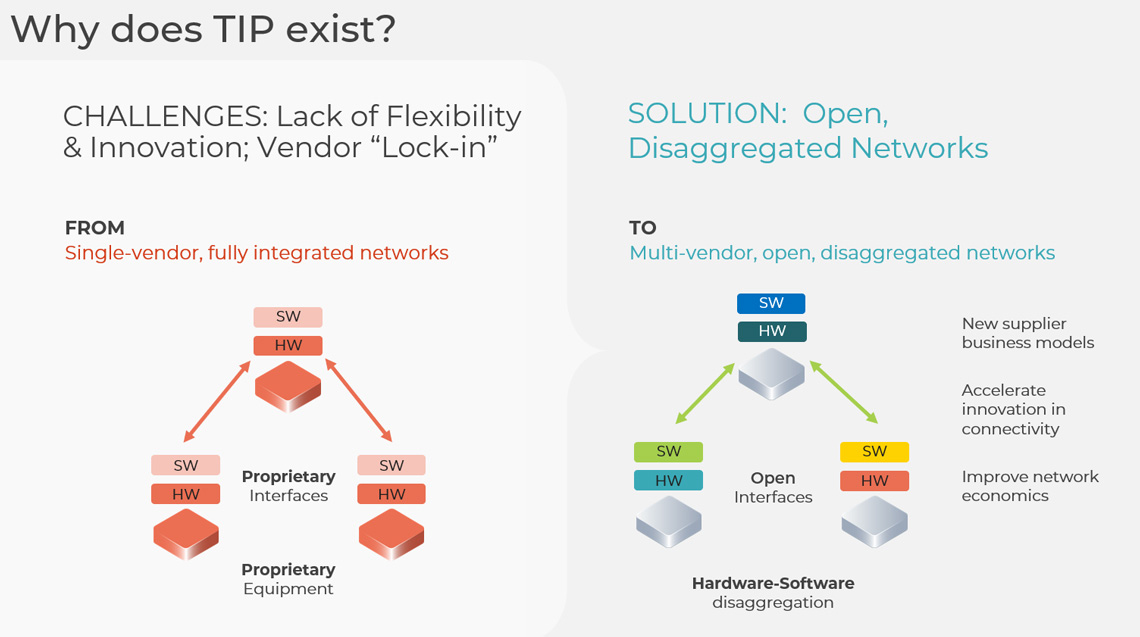
On the left-hand side, you can see a single vendor solution, the hardware and software coming from one vendor with the proprietary interfaces. It is fully integrated which has some benefits, but it's vendor lock-in.
On the other side, the philosophy which we are proposing, and the philosophy which we are working towards is more open and disaggregated networks, multi-vendor rather than vendor lock-in. So you can buy hardware from vendor A, software from vendor B, open interfaces, both between the hardware and the software and towards the network management system to place the power of negotiation back in the hands of the buyers, not in the hands of big OEMs who define roadmaps and drive their own philosophy. This is the reason we exist.
I'll give you a glimpse of what we do. Right from Access to Core, we have multiple interventions.
We are invested in OpenRAN and Open WiFi. Since last year, we have started working on fixed networks, open OLTs and other stuff. Then when it comes to backbone, we are having interventions on Microwave, Optical Transport, Packet Transport, and we also have initiatives around Core and Mobile Core. It pretty much covers end-to-end telecom networks.
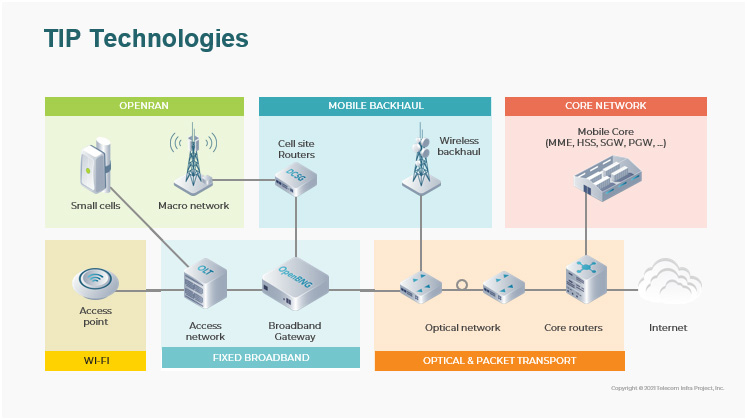
In this slide I’ll show you how we operate, the way we work is a very simple 4 step process. We start working with the service providers, mostly MNOs, on an idea. Once we have this idea, we collect the requirements, put that into a systematic, definition phase, maybe RFI. Once the OEMs respond to that RFI, we invest a lot of time and energy in trialling those technologies in the lab and in the field, then we push it towards a commercial deployment. This is the point of arrival, we are not a standard-building body, we are more interested in rubber hitting the road, making these open technologies commercially deployable. We work very closely with the ONF, OpenRAN, the Open Alliance, OCP, and others to take the inputs of the standards and work closely to get it rolling.
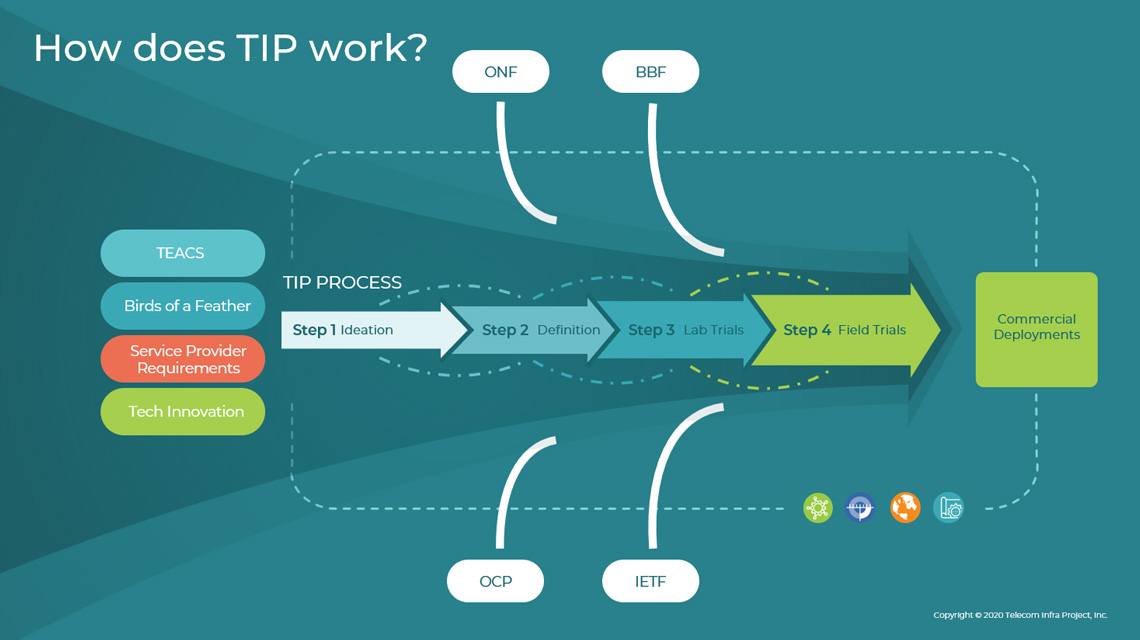
And for ISPs, if you look at the first two steps (Ideation and Definition), we are trying to offload a lot of the work which you do one-to-one with the OEMs. We do it together in a community approach and then we leave the last two (Lab Trials and Field Trials) for you to decide. This is the Telecom Infra Project in a nutshell. Long, long answer for short question!
Mark Downey: Good answer, very interesting. It'd be good to look at some of the projects within TIP. Just before that, I just want to give a quick quote from one of your colleagues, which kind of puts our talk into context a little bit. Johan Hjortas, he's the head of Transport, Network Architecture and Strategy at the Telia company and he's also co-chair of the TIP OOPT project group. He said:
“We're fully committed to the development of a healthy transport ecosystem that can speed up innovation and foster a healthier supply chain. The OOPT community is composed of a greater service and technology providers and I'm looking forward to continuing to work with them to enable transport networks of the future”.
There’s a couple of things within that, I think a healthier supply chain, everyone in the room would agree that improvements in supply chains at the moment will be most welcome! But around that idea of innovation and can we talk a little bit about the backhaul project. I think there's a few different technologies that overlap within that, but maybe we could look into Open Optical Packet Transport, the OOPT. Could you talk a little bit about that and how it's progressing?
Bhartendu Chaurasia: Out of all the interventions that TIP involved in, I love open optical packet transport the most. The reason is, I worked in IP networks in my past career, so I understand it best. Second is I believe all the fancy services which we're talking about today, 5G, immersive experiences, AR, VR, all this is dependent on a very strong, robust transport network underneath. I know buzzwords are OpenRAN, or Metaverse, so on and so forth, but their success all depends on the transport network. In TIP, we have this project group called Open Optical Packet Transport (OOPT), which is an umbrella project group with multiple subgroups underneath. If you can see the blue box called DCSG (Disaggregated Cell Site Gateways), this is one subgroup which talks about a pizza box of 1RU router and an L2 Switch and then we have interventions around disaggregated open routers, which is like aggregation layer, core routers, backbone routers on the packet side; on the optical side, we have technology like optical transponders, Cassini low capacity boxes, and then Phoenix which are 800G optical transponders, and many other project groups, few focused on SDN for transport, others on open source networking operating systems, and so on, so forth.
The most successful intervention in OOPT has been DCSG, and I know Mark will acknowledge that because he has been a partner in crime in making it success because one of his customers has made the most commercial success globally. A lot of partners around the globe started the journey of disaggregation at the DCSG. And now they have reached to OpenRAN and Open WiFi and other sites.
Mark Downey: Within the technology map you showed earlier there's lots of use cases. What will be interesting is how has it transferred into adoption among some of the bigger Telcos globally?
Bhartendu Chaurasia: I have a slide which talks about the typical trials and deployments. This is a busy slide full of logos, and every week we add another new partner who has done a trial or they're deploying this technology.
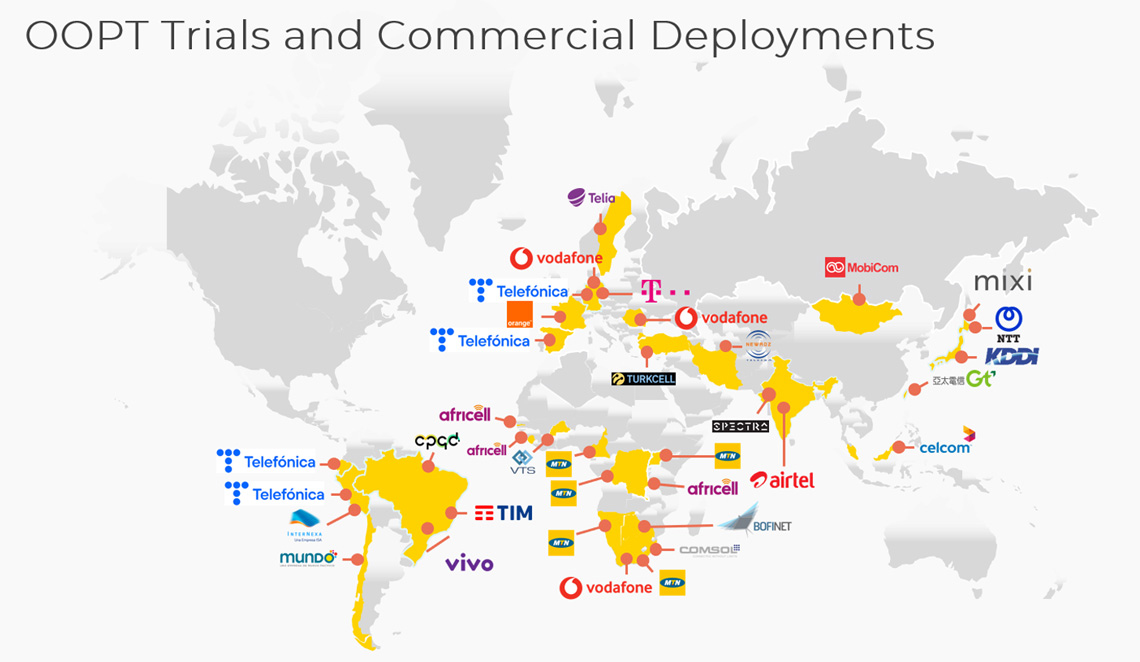
There are around 50+ trials and commercial deployments completed to date, and then the same number again are in progress. Most of them are centered around DCSG and Cassini, they are in 40 countries with 50+ operators, spread across the globe.
Question for audience: Anything in the UK?
Bhartendu Chaurasia: There are a few in the UK but we are not directly engaged with them, I'll come back to that. You can see that most of these are very large-scale MNOs - Telefonica and Vodafone, and the MTNs of the world. We started this journey with large scale MNOs, but now, me being here speaking on this platform highlights the shift in focus towards the ISP community and the Tier-2/Tier-3 MNOs. This was very intentional by design, we thought if we start with the large-scale MNOs to have the benefit of scale. So with a little tech intervention, we can get some scale, we can get these OEMs excited, and the demand will be high. But once the tech matures, we'll come to the real players like you guys.
The feedback which I get from partners after they have deployed this technology (TIP as a team never get into the commercial side of the business once the trials are done, the results are shared, we just move out of the room and leave sellers and buyers to decide on what technology they want to buy), but the reflection we get from customers is that by deploying open technologies at scale, they are achieving easily 25% to 30% savings on OpEx and almost the same number for CapEx depending on what kind of skillset they have in-house, the size of the organization and which part of the world they operate in. But 30% is a number which is uniformly discussed as cost savings so far.
Mark Downey: Moving a little bit away from the technology roadmap, we should dig into some of the real world adoptions and deployments. I guess it'd be good for me to give my perspective on this as a partner working with TIP and ISPs day-to-day. Some examples are Newroz/Gateway in Iraq, at the moment and we've deployed a proof of concept with Cell Site Gateways, that has moved into a pilot project which they're setting up for 5G. We're also starting to work with them on a coherent backbone network using the Cassini box that you mentioned earlier, these are live deployments that we have out there in the field at the moment.
We also have a pretty good story to tell in in Africa, there's lots of greenfield deployments out there where they're looking for innovative, economical ways of getting their networks deployed. There's a need to bring connectivity to rural communities on a scale that we probably don't comprehend relative to the distances we cover in Europe and how they do that. We've worked with Virtual Technologies & Solutions in Burkina Faso, and we’re also working with Afribone in Mali.
I know TIP has had successful projects, I think you mentioned some of them on the map with MTN for example, who are the 7th largest telco in the world I believe, and Africell and Comsol in that region.
EPS Global has been a component of these real-world deployments, both in dealing with TIP or the customer directly, but also as TIP’s fulfillment partner in getting proof of concepts set up in far flung parts of the world.
We've been working in the UK for many years, Vodafone and BT are existing customers, but now we're starting to work more and more with AltNets selling open network solutions into the likes of Netomnia, and then YouFibre. Maybe you can give us a few detailed examples of who you're working with, and what you're doing with them.
Bhartendu Chaurasia: This is a good question, we typically started with large scale MNOs, for the obvious reasons. But once the technology matured we shifted our focus to large, medium and small scale ISPs across the globe.
Right now, we are engaging with 40+ ISPs globally, 15 of them are very active, have started deploying commercially, and some in the deployment phase. When we shifted our focus from MNOs to ISPs, I was talking to some of them and they had a reserved perception about these white boxes. They had lots of questions around support, procurement, how do we buy hardware from Company A and software from Company B? How do we integrate with the enemy; challenges around culture; most of the skillsets on their teams were focused on the Cisco’s, Juniper’s, and the Nokia's of the world. It took some time for us to build that value proposition and break that cynicism in their eyes, they were asking “what is TIP?” and “why this technology?”, either you're confused with both or either of them, but I must say that I was impressed with the way they made their decisions.
My experience with MNOs is that they were slower because they’re bigger, but ISPs are very agile, fast decision makers and excellent executors. Although the challenges are different, like the commercial priorities, deployment, architecture models, operational challenges, working capital etc. I'll give you examples of ISP, from Spectra in India, to Newroz in Iraq, then VTS in Burkina Faso, a couple of projects in Africa, a few in Europe, there are partners who are fixed in mobile, both Turkish Telecom, TurkCell, they're massively invested.
Vodafone, Telefonica, BT, Orange they all are going to deploy large-scale networks with DCSG. In Canada, UGrid; in Brazil, which is full of ISPs, we have a couple of very interesting use cases, Mundo Pacifico; or in Chile, Sky, but not the Sky you know from the UK, it’s a subsidiary of DirecTV in Brazil. They have DCSG deployed.
It is all over the place. If I pick Newros as an example. Our expectation was not very high, because it was the first time we talked to them, and they’re in Iraq. We did not know the competence of the team and so on and so forth. It took 2 weeks for us to make the value proposition clear, but once they were on board, they moved very quickly. Along with EPS Global we worked together on their requirements, we supplied them some test cases which we have built up. They added 10 or 15 different test cases on top. EPS helped us get the boxes shipped to the country in 3-4 weeks, and it was only 6 months from the beginning of the engagement to the point where they had the first box running commercial traffic. Everyone on our team was really amazed to see the fast cycle of acceptance and execution, and what we helped with was curating the requirements and showing them the results from our testing across the globe. They only did the data tests, they wanted to test boxes in different temperatures. They said we may have outages or power and boxes may be sitting at 45C temperature. TIP agreed to test the protocols on that in fields trial to get the performance numbers. Everything went well, and they have been deploying boxes for the past 6 months and I haven’t heard from them, so I'm assuming everything is fine! These are the deployment experiences that I can keep talking about.
Question from Audience: Where does Terragraph sit in this ecosystem?
Bhartendu Chaurasia: The way that Meta or Facebook deal with connectivity is like two buckets. One bucket is through depth where we are participating as a member and we are helping the ecosystem. The other bucket is intervention is phase, Meta connectivity build products internally, and Terragraph is part of that bucket developed by Meta. It's like military technology for the densification of cities. It's like a virtual fiber.
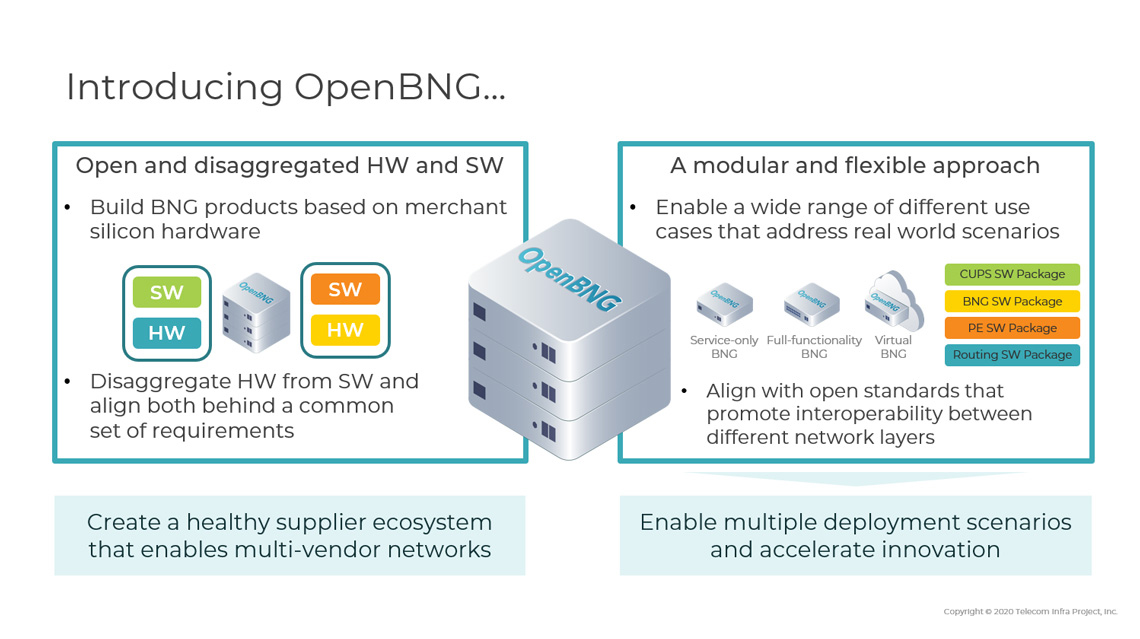
I just want to mention one more thing before we finish up. There are projects apart from the OOPT which we have started, mostly focused around ISPs and fixed networks. There's an initiative called OpenBNG which started last year, and is progressing very well, and then Open OLT, and there's another new project group coming up, which will talk about WiFi and the Metaverse experience in-home. The last speakers were giving numbers and they were phenomenally good. So I encourage you guys to visit the website and to get in touch if you have any questions. We are very much interested to engage.
Glossary of Terms:
- OpenRAN: TIP’s OpenRAN program supports the development of disaggregated and interoperable 2G/3G/4G/5G NR Radio Access Network (RAN) solutions based on service provider requirements.
- TIP: The Telecom Infra Project (TIP) is a global community of companies and organizations working together to accelerate the development and deployment of open, disaggregated, and standards-based technology solutions that deliver the high quality connectivity that the world needs – now and in the decades to come.
- OCP: The Open Compute Project Foundation (OCP) was initiated in 2011 with a mission to apply the benefits of open source and open collaboration to hardware and rapidly increase the pace of innovation in, near and around the data center.
- OOPT: The Open Optical & Packet Transport group is a project group within Telecom Infra Project that works on the definition of open technologies, architectures and interfaces in Optical and IP Networking.
- ONF: The Open Networking Foundation (ONF) is an operator-driven, community-led non-profit consortium fostering and democratizing innovation in software-defined programmable networks.
- Open Alliance: The OPEN Alliance (One-Pair Ether-Net) Inc. is a non-profit, open industry alliance of mainly automotive industry and technology providers collaborating to encourage wide scale adoption of Ethernet-based networks as the standard in automotive networking applications.
- DCSG: Disaggregated Cell Site Gateway
- Microwave: Wireless broadband technology
- Optical Transport: An optical transport network (OTN) is a digital wrapper that encapsulates frames of data, to allow multiple data sources to be sent on the same channel. This creates an optical virtual private network for each client signal. [2]
- Mobile Core: A mobile core network is a central part of the overall mobile network that allows subscribers to get access to the services that they are entitled to use. [1]
- MNOs: Mobile Network Operators
- RFI: Request for Information
- SDN: Software Defined Networking
- AltNets: Alternative Network Providers